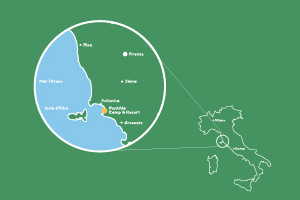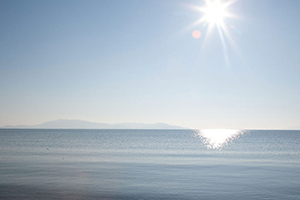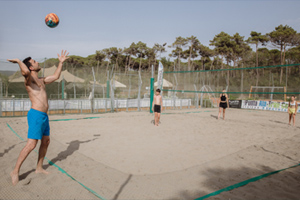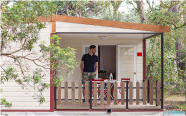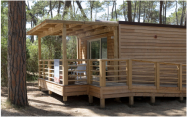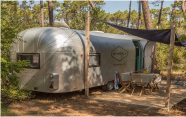Pitigliano: what to see, where to sleep and how to get there
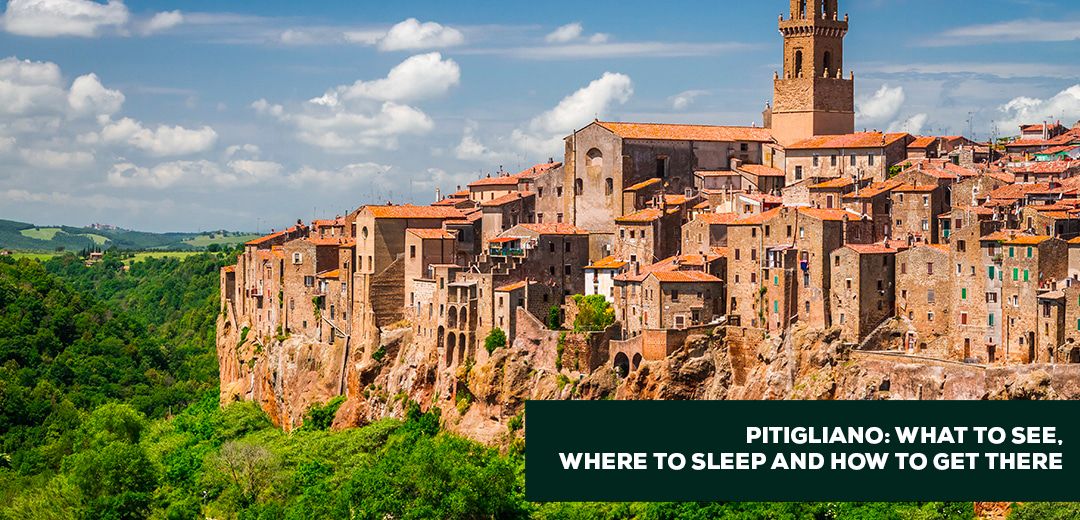
Its location in the heart of Tuscany designates it as the perfect destination for those who aspire to discover both the natural magnificence of the Tuscan countryside and the deep local history and traditions. A tour of Pitigliano can begin with a stroll through the historical centre to explore the main monuments such as the Duomo di Pitigliano, a mix of artistic styles, and the medieval walls. The Medicean aqueduct and the inviting Piazza della Repubblica are a must-see. The Palazzo Orsini, with two museums inside, reveals the cultural wealth of Pitigliano, while the synagogue and the Jewish museum testify to the presence of a historic Jewish community. A variety of accommodation awaits visitors, and despite the remote location, the trip to Pitigliano is certainly well spent.
The Pitigliano tour
Start your tour of Pitigliano by strolling through the characteristic narrow streets of the historic centre. This is the most effective strategy to get in tune with the town and fall in love with it from the first moment. Explore the side paths and hidden corners, pause to observe the valley below from the many panoramic terraces and belvederes, and savour the village, the classic Tuscan houses, the flowers in the windows and the enchanting views. After capturing the magical atmosphere of this place, you will be ready to explore Pitigliano's main monuments and points of interest.
What to see in Pitigliano
Cathedral of Pitigliano
The Cathedral of Pitigliano, one of the many wonders of this town, is officially known as the Cathedral of Saints Peter and Paul. It is a church of medieval origin, the foundations of which date back to the 13th century. However, its construction lasted for 500 years, resulting today in a fascinating fusion of artistic styles. For example, the façade is characterised by its Baroque style, with a 16th-century travertine portal enriched by 18th-century stucco work. To the left of the church rises the bell tower. The interior of the cathedral houses a series of valuable works from different historical periods: from the 19th-century painting of St. Paul of the Cross Preaching, to the Madonna of the Rosary with Saints by Francesco Vanni dated 1609, to the two 19th-century paintings by the painter Pietro Aldi, The Predestination of the Young Ildebrando and Henry IV at Canossa. Not to be missed are the 18th century wooden baptismal font and the side chapels, also rich in sacred works of art.
The Walls of Pitigliano
The walls of Pitigliano constitute an ancient fortification system dating back to medieval times, built by the Aldobrandeschi family for defensive purposes. These walls contain two entrances, the Porta di Sovana and the Porta della Cittadella, built in different periods. However, Pitigliano's first walls have even deeper roots, dating back to Etruscan times: traces of them remain, partly visible, in the historic centre to the north-west, not far from the Porta di Sovana. Today, the walls are only partially preserved in the centre, with some sections incorporated into the outer walls of various buildings, while other parts have been demolished. A large part of the walls are clad in tuff and, along their course, there are several panoramic terraces overlooking the cliff.
The Medici aqueduct
The Medici aqueduct of Pitigliano, initially intended to supply water to the village, is today a majestic work whose grandeur has been preserved. Its construction began in the 16th century, but the irregular nature of the territory complicated the process, extending the construction time for more than a century. Today, the aqueduct, with its tuff lining, can still be admired in all its magnificence, blending harmoniously with its surroundings.
Piazza della Repubblica
Piazza della Repubblica is the gateway to the historic town of Pitigliano, representing for many the first vantage point where they can stop to capture the landscape in splendid photographs. It takes the form of an elongated piazza in a north-south direction, from which Via Roma, the main artery of the centre, branches off to the east. The square is carefully and cleanly maintained, making it an essential stop for visitors to the town. On the south side of Piazza della Repubblica stands the monumental Sette Cannelle fountain, built in the 16th century at the behest of Count Gianfranco Orsini. Here is also the end of the Medici aqueduct, characterised by imposing arches covered in tuff. The water gushes from spouts adorned with sculptures depicting the heads of various animals.
Orsini Palace
Palazzo Orsini in Pitigliano is an imposing castle set in the heart of the historic centre. Its origin dates back to the 12th century, when it served as a convent; it was later transformed into a fortress by the Aldobrandeschi, who chose it as their residence. However, the palace takes its name from the Orsini family, heirs of the Aldobrandeschi, who governed Pitigliano in the following centuries, until 1600. Today, Palazzo Orsini houses two museums: the Diocesan Museum of Sacred Art, also known as the Palazzo Orsini Museum, and the Archaeological Museum of Pitigliano. The first, divided into 18 rooms, presents a collection of sacred art masterpieces. The second, on the other hand, consists of 6 rooms and is devoted to exhibits from the Poggio Buco area and the historic site of Pitigliano.
Pitigliano, also known as 'Little Jerusalem', hides a very special reason for this nickname: it is revealed through a visit to the synagogue and the Jewish museum, both of which bear witness to the town's ancient Jewish ghetto. The synagogue, built in the Romanesque style, dates back to 1598, with interior furnishings mainly from the 17th and 18th centuries. Over the centuries, the synagogue has undergone numerous restorations, most recently in 1995 by the municipality of Pitigliano. On the other hand, the Jewish Museum offers the opportunity to unveil the mysteries of the local Jewish community that lived in the ghetto populated in the early 17th century. Both the Pitigliano synagogue and the Jewish museum can be visited every day except Saturdays.
Church of the Madonna delle Grazie
Pitigliano is home to the Church of the Madonna delle Grazie, located along the regional road SR74, just one kilometre from the town centre. This small but charming church is particularly notable for its interior beauty, adorned with refined stuccoes that attract the eye. But what really draws visitors to the Church of Madonna delle Grazie is the exceptional belvedere, located at a bend in the SR74 road, an ideal place to park the car and enjoy a breathtaking view. From here, in fact, you can admire Pitigliano emerging imposingly from the tuff cliff, offering a unique spectacle.
Where to sleep in Pitigliano
The ancient village of Pitigliano is dotted with flats and B&Bs, available in every corner. These structures are often historical dwellings that have been carefully renovated to welcome visitors, some kept in traditional style, others renovated in modern style, and still others that highlight the distinctive features of the place, such as the tuff. If you wish to experience Pitigliano to the fullest, opt for a stay in the historic centre, especially during the early morning hours when day visitors have not yet arrived, or in the evening when the crowds have already dispersed. However, bear in mind that the centre of Pitigliano is not accessible to cars, so you will have to park outside and arrange with your accommodation for luggage transport. If, on the other hand, you prefer an experience immersed in the nature of the Tuscan Maremma, you can opt for one of the old farmhouses that have been renovated and converted into agritourisms, located a few kilometres away. Here you can sleep in an oasis of tranquillity surrounded by vineyards, hills and rows of vines; many of these agritourisms also offer an in-house restaurant where you can savour local, zero-kilometre specialities. The only disadvantage of this option is that you will need a car to visit Pitigliano.
Map of Pitigliano
How to reach Pitigliano
Pitigliano is located at the south-eastern end of the region, making it not always easy to reach. From Grosseto it takes more than an hour's drive, about 80 kilometres.
- From Florence, it takes more than two and a half hours. One must take the A1 motorway to the Chiusi-Chianciano Terme exit, and then proceed on a series of provincial roads that pass through places like San Casciano dei Bagni, Castell'Azzara and Sorano.
- From Siena it takes two hours to travel along the SR2, or Via Cassia, to Ponte a Rigo and then continue along the SP20.
From Arezzo we need the same time, but use the A1 motorway as far as Chiusi-Chianciano Terme. For those travelling from the Tuscan coastal cities, such as Pisa and Livorno, the journey time is about three hours, passing first through Grosseto and then Albinia, and then continuing on the SR74 to Pitigliano.
If you are planning to travel by public transport, be aware that reaching Pitigliano can be a challenge.
- From Florence: it takes four bus changes, and the journey time varies from 4 ½ to 6 hours. From Grosseto: you must use the provincial transport buses, but there are no direct buses from Grosseto to Pitigliano, and the journey can take up to three hours.
Where Pitigliano is located
Pitigliano is located in the province of Grosseto, in the enchanting region of Tuscany, Italy. This charismatic village unfolds a short distance from the border with the Lazio region. Pitigliano is distinguished by its singular location, built as it is on a salient of tuff, a kind of volcanic rock, which gives it an extremely fascinating appearance. Its location in the heart of Tuscany makes it an ideal point of interest for those who yearn to discover both the natural splendour of the Tuscan landscape and the area's profound history and culture.












